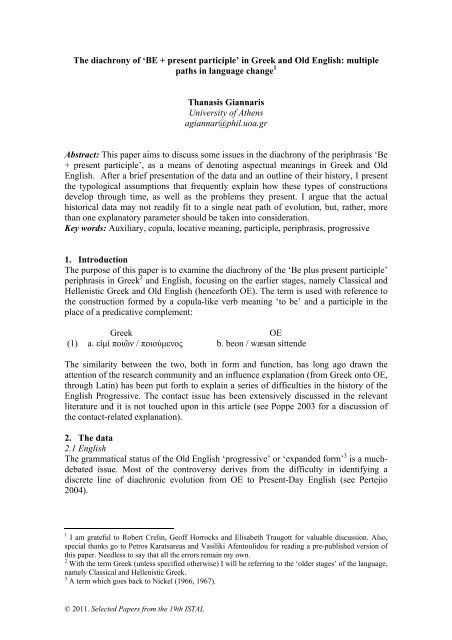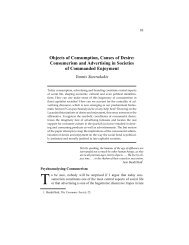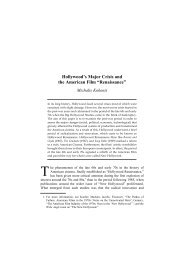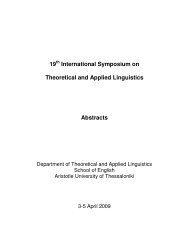The diachrony of 'BE + present participle' in Greek and Old English ...
The diachrony of 'BE + present participle' in Greek and Old English ...
The diachrony of 'BE + present participle' in Greek and Old English ...
Create successful ePaper yourself
Turn your PDF publications into a flip-book with our unique Google optimized e-Paper software.
<strong>The</strong> <strong>diachrony</strong> <strong>of</strong> ‘BE + <strong>present</strong> participle’ <strong>in</strong> <strong>Greek</strong> <strong>and</strong> <strong>Old</strong> <strong>English</strong>: multiple<br />
paths <strong>in</strong> language change 1<br />
© 2011. Selected Papers from the 19th ISTAL<br />
Thanasis Giannaris<br />
University <strong>of</strong> Athens<br />
agiannar@phil.uoa.gr<br />
Abstract: This paper aims to discuss some issues <strong>in</strong> the <strong>diachrony</strong> <strong>of</strong> the periphrasis ‘Be<br />
+ <strong>present</strong> participle’, as a means <strong>of</strong> denot<strong>in</strong>g aspectual mean<strong>in</strong>gs <strong>in</strong> <strong>Greek</strong> <strong>and</strong> <strong>Old</strong><br />
<strong>English</strong>. After a brief <strong>present</strong>ation <strong>of</strong> the data <strong>and</strong> an outl<strong>in</strong>e <strong>of</strong> their history, I <strong>present</strong><br />
the typological assumptions that frequently expla<strong>in</strong> how these types <strong>of</strong> constructions<br />
develop through time, as well as the problems they <strong>present</strong>. I argue that the actual<br />
historical data may not readily fit to a s<strong>in</strong>gle neat path <strong>of</strong> evolution, but, rather, more<br />
than one explanatory parameter should be taken <strong>in</strong>to consideration.<br />
Key words: Auxiliary, copula, locative mean<strong>in</strong>g, participle, periphrasis, progressive<br />
1. Introduction<br />
<strong>The</strong> purpose <strong>of</strong> this paper is to exam<strong>in</strong>e the <strong>diachrony</strong> <strong>of</strong> the ‘Be plus <strong>present</strong> participle’<br />
periphrasis <strong>in</strong> <strong>Greek</strong> 2 <strong>and</strong> <strong>English</strong>, focus<strong>in</strong>g on the earlier stages, namely Classical <strong>and</strong><br />
Hellenistic <strong>Greek</strong> <strong>and</strong> <strong>Old</strong> <strong>English</strong> (henceforth OE). <strong>The</strong> term is used with reference to<br />
the construction formed by a copula-like verb mean<strong>in</strong>g ‘to be’ <strong>and</strong> a participle <strong>in</strong> the<br />
place <strong>of</strong> a predicative complement:<br />
<strong>Greek</strong> OE<br />
(1) a. εἰμί ποιῶν / ποιούμενος b. beon / wæsan sittende<br />
<strong>The</strong> similarity between the two, both <strong>in</strong> form <strong>and</strong> function, has long ago drawn the<br />
attention <strong>of</strong> the research community <strong>and</strong> an <strong>in</strong>fluence explanation (from <strong>Greek</strong> onto OE,<br />
through Lat<strong>in</strong>) has been put forth to expla<strong>in</strong> a series <strong>of</strong> difficulties <strong>in</strong> the history <strong>of</strong> the<br />
<strong>English</strong> Progressive. <strong>The</strong> contact issue has been extensively discussed <strong>in</strong> the relevant<br />
literature <strong>and</strong> it is not touched upon <strong>in</strong> this article (see Poppe 2003 for a discussion <strong>of</strong><br />
the contact-related explanation).<br />
2. <strong>The</strong> data<br />
2.1 <strong>English</strong><br />
<strong>The</strong> grammatical status <strong>of</strong> the <strong>Old</strong> <strong>English</strong> ‘progressive’ or ‘exp<strong>and</strong>ed form’ 3 is a muchdebated<br />
issue. Most <strong>of</strong> the controversy derives from the difficulty <strong>in</strong> identify<strong>in</strong>g a<br />
discrete l<strong>in</strong>e <strong>of</strong> diachronic evolution from OE to Present-Day <strong>English</strong> (see Pertejio<br />
2004).<br />
1<br />
I am grateful to Robert Crel<strong>in</strong>, Ge<strong>of</strong>f Horrocks <strong>and</strong> Elisabeth Traugott for valuable discussion. Also,<br />
special thanks go to Petros Karatsareas <strong>and</strong> Vasiliki Afentoulidou for read<strong>in</strong>g a pre-published version <strong>of</strong><br />
this paper. Needless to say that all the errors rema<strong>in</strong> my own.<br />
2<br />
With the term <strong>Greek</strong> (unless specified otherwise) I will be referr<strong>in</strong>g to the ‘older stages’ <strong>of</strong> the language,<br />
namely Classical <strong>and</strong> Hellenistic <strong>Greek</strong>.<br />
3<br />
A term which goes back to Nickel (1966, 1967).
206 Thanasis Giannaris<br />
Table 1. <strong>The</strong> history <strong>of</strong> the <strong>English</strong> Progressive<br />
Period 4 O.E. (5th-10th c.) M.E. (10th-15th) EPDE (16th-18th) PDE (19th-today)<br />
Form Beon / wesan + -ende Be + (on, <strong>in</strong>) + -<br />
ende, -<strong>in</strong>ge, -<strong>in</strong>g<br />
(
<strong>The</strong> <strong>diachrony</strong> <strong>of</strong> ‘BE + <strong>present</strong> participle’ <strong>in</strong> <strong>Greek</strong> <strong>and</strong> <strong>Old</strong> <strong>English</strong> 207<br />
Table 4. Predicates most commonly attested <strong>in</strong> the <strong>Greek</strong> periphrasis<br />
States/change <strong>of</strong> state Activities<br />
οἰκῶ, κατοικῶ ‘dwell’, καλῶ ‘name’,<br />
γιγνώσκω ‘know’, ἀκμάζω ‘bloom’,<br />
κοιμάμαι, καθεύδω ‘sleep’, etc.<br />
διώκω ‘pursue’, πρόσειμι ‘go’, βαδίζω<br />
‘walk’, διδάσκω ‘teach’, πορεύομαι<br />
‘proceed’ etc.<br />
(3) καὶ θῆραι πάντων ὁπόσα ἐστὶν ἀγρευόμενα θηρία<br />
<strong>and</strong> preys all-GEN which is be<strong>in</strong>g-hunted beasts<br />
‘there is hunt<strong>in</strong>g <strong>of</strong> all manner <strong>of</strong> beasts <strong>in</strong> the chase’ (Xen. Anab. 5, 3, 9, 1)<br />
In Hellenistic times, the construction occurs far more frequently than <strong>in</strong> the Classical<br />
period, accompanied by a remarkable rise <strong>in</strong> the use <strong>of</strong> transitive verbs <strong>in</strong> the<br />
predicative position:<br />
(4) καὶ ἦν Ἰωάννης οἰκοδομῶν ναοὺς<br />
<strong>and</strong> was John build<strong>in</strong>g temples<br />
‘<strong>and</strong> John was build<strong>in</strong>g temples’ (Acta John 44, 6)<br />
3. How ‘progressive’ ‘Be + <strong>present</strong> participle’ is?<br />
3. 1. Typological predictions<br />
Previous research on the <strong>diachrony</strong> <strong>of</strong> the aspectual periphrases refers to<br />
grammaticalization processes as play<strong>in</strong>g a major role <strong>in</strong> their development. It must be<br />
borne <strong>in</strong> m<strong>in</strong>d that grammaticalization beg<strong>in</strong>s either with essentially lexical source<br />
material, us<strong>in</strong>g open-class categories, becom<strong>in</strong>g reanalyzed to more closed ones, or with<br />
a series <strong>of</strong> changes that the lexical item undergoes on its way to becom<strong>in</strong>g <strong>in</strong>creas<strong>in</strong>gly<br />
grammatical (Hopper & Traugott 2003: 2). <strong>The</strong> view supported <strong>in</strong> the typological<br />
literature (Bybee et al. 1994, Devitt 1994, He<strong>in</strong>e & Kuteva 2002) is that imperfective<br />
‘grams’ (i.e. grammatical forms) derive almost exclusively from patterns that <strong>in</strong>volve<br />
some element with salient locative mean<strong>in</strong>g <strong>and</strong> that progressivity is the one to be met<br />
first <strong>in</strong> a nascent aspectual gram. <strong>The</strong> imperfective mean<strong>in</strong>gs occur later via semantic<br />
generalization (Comrie 1976: 32):<br />
(4) progressive > cont<strong>in</strong>uous > habitual > imperfective<br />
Progressive aspect is by def<strong>in</strong>ition only compatible with verbs denot<strong>in</strong>g activities.<br />
Hence the predicates denot<strong>in</strong>g temporary activities collocate earlier with the emerg<strong>in</strong>g<br />
aspectual construction as compared to those be<strong>in</strong>g <strong>in</strong>herently permanent <strong>in</strong> their<br />
semantics (<strong>and</strong> not vice versa). As we proceed on the cl<strong>in</strong>e, an expansion to other types<br />
<strong>of</strong> predicates takes place (e.g. states or stative events) br<strong>in</strong>g<strong>in</strong>g out the other aspectual<br />
read<strong>in</strong>gs.<br />
3.2 Idiosyncratic properties <strong>of</strong> the periphrasis<br />
‘Be + <strong>present</strong> participle’ appears to be highly idiosyncratic with regard to the follow<strong>in</strong>g<br />
properties; a typical OE example as the one <strong>in</strong> (5) can be more aptly described as<br />
express<strong>in</strong>g a generic quality <strong>of</strong> the subject <strong>and</strong> not an activity <strong>in</strong> progress.<br />
(5) Sume syndan creopende on eorðan mid eallum lichoman,<br />
Some are creep<strong>in</strong>g on earth with their whole body<br />
‘Some creep/ are creepers on the earth with their whole body’<br />
(Ælfric’s Lives, I, II 52)
208 Thanasis Giannaris<br />
<strong>The</strong>re are, however, <strong>in</strong>dications that habitual read<strong>in</strong>gs are equally possible:<br />
(6a) καὶ ἦν διδάσκων τὸ καθ’ ἡμέραν ἐν τῷ ἱερῷ (Ν.Τ. Luc. 19, 47, 1)<br />
<strong>and</strong> he-was teach<strong>in</strong>g the <strong>in</strong> day <strong>in</strong> the temple<br />
‘he used to teach/taught <strong>in</strong> the temple every day’ (Ν.Τ. Luc. 19, 47, 1)<br />
(6b) hwilum wæs on horse sittende, ac <strong>of</strong>tor on his fotum gangende<br />
sometimes was on horse sitt<strong>in</strong>g <strong>and</strong> <strong>of</strong>ten on his foot-GEN he-went<br />
‘at times he mounted on horseback, more <strong>of</strong>ten he went on foot’ (Blick<strong>in</strong>g<br />
Homil. 362, 19) (Pertejio 2004: 92)<br />
This is not the case with the usual markers <strong>of</strong> the progressive:<br />
(7) ?I am teach<strong>in</strong>g <strong>in</strong> school every day<br />
(but: I am teach<strong>in</strong>g <strong>in</strong> school every day this year)<br />
On the basis <strong>of</strong> OE examples such as (5), Bybee et al. (1994: 135) cannot accommodate<br />
<strong>in</strong> their theory <strong>of</strong> grammaticalization the fact that the fully-fledged <strong>English</strong> Progressive<br />
developed out <strong>of</strong> OE sources 7 . Accord<strong>in</strong>g to them, cases like (5) are nongrammaticalized<br />
constructions, only marg<strong>in</strong>ally connected to aspectual mean<strong>in</strong>gs. Thus,<br />
the pattern ‘be + <strong>present</strong> participle’ does not conform to the diachronic path, whereby<br />
progressivity is grammaticalized first <strong>and</strong> the other mean<strong>in</strong>gs emerge later <strong>in</strong> the<br />
process. <strong>The</strong>ir conclusion is supported by the fact that the construction does not <strong>in</strong>clude<br />
some element with explicit locative mean<strong>in</strong>g (e.g. a preposition), which is considered to<br />
be the almost exclusive source for progressive grammatical forms.<br />
Another major issue is that the periphrasis can be <strong>in</strong>terpreted plausibly either as a<br />
copular construction, <strong>in</strong> which the <strong>present</strong> participle <strong>of</strong> a lexical verb functions as the<br />
subject complement <strong>in</strong> (8a), or as an analytic verbal complex with, more likely,<br />
progressive semantic value (8b), while <strong>in</strong> other cases both <strong>in</strong>terpretations (copular<br />
construction <strong>and</strong> verb phrase) re<strong>present</strong> equally plausible alternatives (8c):<br />
<strong>Greek</strong> OE<br />
(8a) ἔτι εἰμὶ ζῶν ƥe synt on lichomum lifgende (Blick. Hom 275)<br />
still I-am liv<strong>in</strong>g are on body liv<strong>in</strong>g<br />
‘I am still alive’ ‘(we) who are alive <strong>in</strong> the body’<br />
(Sept. Dan. 6, 2, 2) (Blick. Hom 275)<br />
(8b) καὶ…ἦν πολεμῶν wæs feohtende<br />
<strong>and</strong> he-was fight<strong>in</strong>g he-was fight<strong>in</strong>g<br />
‘<strong>and</strong> he was fight<strong>in</strong>g’ (Sept. Reg. 6, 8, 1) ‘he was fight<strong>in</strong>g’ (Oros. 30, 18)<br />
(8c) ἦν ἡμέρας τρεῖς μὴ βλέπων hio ðystende wæs<br />
he-was days three not see<strong>in</strong>g she thirst<strong>in</strong>g was<br />
‘he could not see / was bl<strong>in</strong>d for three days’ ‘she was thirsty’<br />
(Ν.Τ. Ac. 9, 9, 1) (Oros. 30, 20)<br />
7 Instead, they prefer a different explanation, which would more likely follow the general patterns <strong>of</strong><br />
grammaticalization start<strong>in</strong>g from a later period (namely the M.E., when the explicitly locative<br />
prepositional-based periphrasis developed – cf. Jespersen 1912).
<strong>The</strong> <strong>diachrony</strong> <strong>of</strong> ‘BE + <strong>present</strong> participle’ <strong>in</strong> <strong>Greek</strong> <strong>and</strong> <strong>Old</strong> <strong>English</strong> 209<br />
<strong>The</strong> transitivity <strong>of</strong> the verb from which the participial form has derived, constitutes<br />
the basic criterion for label<strong>in</strong>g the constructions as ‘more’ adjectival’ or ‘more’ verbal<br />
(Traugott 1992: 189):<br />
(9) hio ðystende wæs on symbel mannes blodes…geligre fremmende wæs<br />
she thirst<strong>in</strong>g was … man-GEN blood, fornication perform<strong>in</strong>g was<br />
‘she was thirst<strong>in</strong>g … for a man’s blood…she was fornicat<strong>in</strong>g’ (Oros. 30, 26)<br />
In (9), the first participle (be<strong>in</strong>g <strong>in</strong>transitive) could be taken as express<strong>in</strong>g state (‘always<br />
thirsty’ rather than ‘always thirst<strong>in</strong>g’), whereas the second (transitive) can hardly do so.<br />
<strong>Greek</strong> data behave along the same l<strong>in</strong>e:<br />
(10a) καὶ αὐτὸς ἦν ἐν τῇ πρύμνῃ … καθεύδων<br />
<strong>and</strong> he-was <strong>in</strong> the stern … sleep<strong>in</strong>g<br />
‘he was sleep<strong>in</strong>g/asleep <strong>in</strong> the stern’(N.T. Mark. 4, 38, 2)<br />
(10b) ὁ δὲ Κορνήλιος ἦν προσδοκῶν αὐτούς<br />
the PART Cornelius was wait<strong>in</strong>g them<br />
‘Cornelius was wait<strong>in</strong>g upon them’ (Ν.Τ. Acta 12, 24, 3)<br />
3.3 Reanalysis <strong>and</strong> participial verbalization<br />
Ziegeler (1999, 2006), <strong>in</strong> order to account for the problems highlighted <strong>in</strong> the<br />
typological literature, puts forth an analysis <strong>of</strong> the <strong>diachrony</strong> <strong>of</strong> the <strong>English</strong> Progressive,<br />
argu<strong>in</strong>g that the development took place <strong>in</strong>itially through <strong>in</strong>ferences result<strong>in</strong>g from a<br />
reanalysis <strong>of</strong> a certa<strong>in</strong> type <strong>of</strong> agent nouns as adjectives. Because <strong>of</strong> their generic nature,<br />
these nouns gradually acquired grammatical aspectual senses <strong>of</strong> durativity. Thus the<br />
follow<strong>in</strong>g developments might have occurred:<br />
(11a) Adjective: He is [rul<strong>in</strong>g] (rul<strong>in</strong>g is a de-nom<strong>in</strong>al generic adjective = ‘he rules/is<br />
a rul<strong>in</strong>g one’), e.g. rælende; therefore,<br />
(11b) Participle (or non-f<strong>in</strong>ite verbal form): He [is rul<strong>in</strong>g] now (rul<strong>in</strong>g is a verbal<br />
participle express<strong>in</strong>g an on-go<strong>in</strong>g situation extend<strong>in</strong>g over speaker reference<br />
time)<br />
Ziegeler’s arguments exclude any explicit process <strong>of</strong> grammaticalization from the<br />
change scenario; the construction changed its status from ‘copula sentence’ to ‘verbal<br />
periphrasis’ through (syntactic <strong>and</strong> semantic) reanalysis. In this way, she overcomes the<br />
thorny alternative <strong>of</strong> postulat<strong>in</strong>g a grammaticalization path from the already<br />
semantically bleached copula verb (without explicit locative mean<strong>in</strong>g) <strong>in</strong>to an auxiliary.<br />
A closer look, however, to the data (both <strong>in</strong> <strong>English</strong> <strong>and</strong> <strong>Greek</strong>) reveals that this analysis<br />
leaves out an important parameter.<br />
4. <strong>The</strong> locative source revisited<br />
<strong>The</strong> exclusion <strong>of</strong> the locative mean<strong>in</strong>g from the ‘Be + <strong>present</strong> participle’ periphrasis has<br />
been based on the assumption that the periphrasis derives directly from a copula<br />
predication which exhibits the follow<strong>in</strong>g structure:<br />
(12) [Copula + participle] > periphrasis
210 Thanasis Giannaris<br />
However, there are data that can be <strong>in</strong>terpreted as <strong>in</strong>volv<strong>in</strong>g locative semantic nuance,<br />
thus po<strong>in</strong>t<strong>in</strong>g to a structural modification <strong>of</strong> (12):<br />
(13) [Locative copula] + [participle] > periphrasis<br />
Accord<strong>in</strong>g to the latter option, the verb ‘to be’ can be construed not as a copula proper<br />
but rather as hav<strong>in</strong>g a locative <strong>and</strong>/or existential mean<strong>in</strong>g, whereas the participle is not<br />
the copula complement, but a sentential adjunct. An analysis <strong>of</strong> the construction along<br />
the l<strong>in</strong>es <strong>of</strong> (13) is favoured by the fact that, whenever a locative/existential semantic<br />
nuance is <strong>in</strong>volved, a dist<strong>in</strong>ctive, durative mean<strong>in</strong>g <strong>of</strong> the periphrasis can be more<br />
readily established as opposed to cases when no such semantic premise exists. For<br />
example, if we compare the periphrases <strong>in</strong> (14.a) <strong>and</strong> (14.b), we will notice that the<br />
second, which <strong>in</strong>volves a locative copula, accords with the progressive read<strong>in</strong>g better<br />
than the first, which fluctuates between a verbal <strong>and</strong> a non-verbal/adjectival read<strong>in</strong>g:<br />
(14a) οἵτινες ἄρα ἦσαν νομοθεντοῦντες<br />
who therefore they-were legislat<strong>in</strong>g<br />
‘those who legislated/were legislators’ (Plat. Leges 692b, 2)<br />
(14b) ἦσαν δὲ αὐτόθι κατοικοῦντες Θρᾷκές τινες<br />
they-were PART there dwell<strong>in</strong>g Thracians some<br />
‘some Thracians were liv<strong>in</strong>g there / there were some Thracians liv<strong>in</strong>g<br />
there’ (Hellan. Fr. 71a, 4)<br />
Such a property is a basic characteristic <strong>of</strong> the periphrasis <strong>in</strong> Classical <strong>Greek</strong>. A brief<br />
survey <strong>of</strong> the periphrases found <strong>in</strong> Herodotus (5 th c. B.C.) reveals that 21 cases <strong>in</strong>volve a<br />
locative copula <strong>and</strong> only 9 do not.<br />
In Hellenistic – Roman <strong>Greek</strong> this feature is still substantial; the periphrases found <strong>in</strong><br />
Biblical <strong>Greek</strong> strongly exhibit structural ambiguity <strong>in</strong> the <strong>in</strong>terpretation <strong>of</strong> the copula<br />
rather than ambiguity <strong>in</strong> the adjectival versus verbal status <strong>of</strong> the participle.<br />
(15a) καθ’ ἡμέραν ἤμην πρὸς ὑμᾶς ἐν τῷ ἱερῷ διδάσκων<br />
<strong>in</strong> day I-was to you <strong>in</strong> the temple teach<strong>in</strong>g<br />
‘I was teach<strong>in</strong>g you <strong>in</strong> the temple every day/ I was every day <strong>in</strong> the temple<br />
teach<strong>in</strong>g you’ (Ν.Τ. Marc 14, 49, 2)<br />
(15b) ἦν γὰρ διδάσκων αὐτοὺς ὡς ἐξουσίαν ἔχων<br />
he-was PART teach<strong>in</strong>g them that power hav<strong>in</strong>g<br />
‘he was teach<strong>in</strong>g them that he had power’ (Ν.Τ. Matth. 7, 29, 1).<br />
<strong>The</strong> relative <strong>in</strong>dependence <strong>of</strong> the elements <strong>of</strong> the periphrasis may be preserved <strong>in</strong> the<br />
tendency <strong>of</strong> locative adverbial modification to <strong>in</strong>tervene between the f<strong>in</strong>ite verb <strong>and</strong> the<br />
verbal complement. This feature perta<strong>in</strong>s to the strong locative/existential mean<strong>in</strong>g <strong>of</strong><br />
the be-form <strong>and</strong> po<strong>in</strong>ts to a residual bi-clausality <strong>of</strong> the periphrasis:<br />
(16) ὅσοι δὲ Κάρων εἰσὶ ἐν Αἰγύπτῳ οἰκέοντες<br />
which PART Kares-GEN are <strong>in</strong> Egypt dwell<strong>in</strong>g<br />
‘those <strong>of</strong> Kares who live <strong>in</strong> Egypt’ (Herod. 2, 61, 5)<br />
<strong>The</strong> difficulty with this sort <strong>of</strong> data is <strong>in</strong> identify<strong>in</strong>g to what degree the clause union has<br />
occurred. As a rule <strong>of</strong> thumb, it can be said that the more the verb is <strong>in</strong>dividually<br />
modified, the more it is understood to function as a lexical verb, whereas a lack <strong>of</strong> not
<strong>The</strong> <strong>diachrony</strong> <strong>of</strong> ‘BE + <strong>present</strong> participle’ <strong>in</strong> <strong>Greek</strong> <strong>and</strong> <strong>Old</strong> <strong>English</strong> 211<br />
shared modification is suggestive <strong>of</strong> the conceptual union <strong>of</strong> the two verbal forms. For<br />
example <strong>in</strong> (17), even though the two elements are <strong>in</strong> absolute adjacency, the locative<br />
adverbial is open to be <strong>in</strong>terpreted either with only ‘be’ or with both ‘be’ <strong>and</strong> the<br />
participle:<br />
(17) ἔνθα ἦσαν προφυλάσσουσαι νέες τρεῖς Ἑλληνίδες<br />
there were guard<strong>in</strong>g ships three <strong>Greek</strong><br />
‘three <strong>Greek</strong> ships were guard<strong>in</strong>g there / there were three <strong>Greek</strong> ships,<br />
guard<strong>in</strong>g’ (Herod. 1, 179, 3)<br />
In (18), the locative adverbial modifies the whole construction <strong>and</strong> thus favours the<br />
implementation <strong>of</strong> the periphrastic read<strong>in</strong>g:<br />
(18) Καὶ γὰρ ἐγγύς τῆς θύρας ἤδη βαδίζων εἰμὶ τῆσδ’,<br />
And PΑRT close the door-GEN already walk<strong>in</strong>g am-I this-GEN<br />
‘<strong>and</strong> already I was walk<strong>in</strong>g close to the door’ (Aristoph. Ranae 36)<br />
Elsewhere, a co-existence <strong>of</strong> spatial <strong>and</strong> temporal locational modification may be<br />
observed (especially <strong>in</strong> the later stages <strong>of</strong> the language). See the examples <strong>in</strong> (19):<br />
(19) ἦν δὲ τὰς ἡμέρας ἐν τῷ ἱερῷ διδάσκων<br />
he-was PART the days <strong>in</strong> the temple teach<strong>in</strong>g<br />
‘<strong>and</strong> he was teach<strong>in</strong>g these days <strong>in</strong> the temple’ (N.T. Luc. 27, 1, 39, 1)<br />
Not surpris<strong>in</strong>gly, this dimension <strong>of</strong> the periphrasis can also be observed <strong>in</strong> the OE<br />
data. <strong>The</strong> close <strong>in</strong>terconnection <strong>of</strong> the residual locative/existential mean<strong>in</strong>g <strong>of</strong> the verb<br />
‘to be’ <strong>and</strong> the temporal adverbials that potentially disambiguate the durative or habitual<br />
aspectuality <strong>of</strong> the periphrasis are systematically found <strong>in</strong> OE:<br />
(20a) Lazarus …. he on byrgenne wæs ful wuniende<br />
Lazarus … he on tomb was dirty abid<strong>in</strong>g<br />
‘Lazarus … he was abid<strong>in</strong>g corrupt <strong>in</strong> the tomb/ he was <strong>in</strong> the tomb, abid<strong>in</strong>g<br />
corrupt’ (<strong>The</strong> Blickl<strong>in</strong>g Homilies R 153) (Ziegeler 2006: 64)<br />
(20b) Æƥelwulf cyn<strong>in</strong>g...ferde to Rome…ƥær wæs twelf monaƥ wuniende<br />
Æƥelwulf k<strong>in</strong>g … went to Rome…there was twelve months liv<strong>in</strong>g<br />
‘K<strong>in</strong>g Æƥelwulf…went to Rome…he lived there twelve months’ (Ang.Chr. 855)<br />
Noteworthily, <strong>in</strong> later prose texts, the locative modification recedes <strong>in</strong> favour <strong>of</strong> purely<br />
temporal expressions, as <strong>in</strong> (21) below. This fact should be deemed as evidence for the<br />
shap<strong>in</strong>g <strong>of</strong> well-grounded aspectual mean<strong>in</strong>gs.<br />
(21) & ƥy ilcan geare ferde to Rome …, & ƥær was xii monaƥ wuniende<br />
<strong>and</strong> the same year he- proceeded to Rome …, <strong>and</strong> there was 12 months stay<strong>in</strong>g<br />
‘<strong>and</strong> the same year he proceeded to Rome …, <strong>and</strong> rema<strong>in</strong>ed there 12 months’<br />
(Two <strong>of</strong> the Saxon Chronicles Rarallel, R. 855.4)<br />
To sum up, the data br<strong>in</strong>g back <strong>in</strong>to play the locative source that usually underlies the<br />
rise <strong>of</strong> progressive markers <strong>and</strong> reveal how it <strong>in</strong>tersects with a non-grammaticalization<br />
process (such as the verbal reanalysis <strong>of</strong> the participial form). <strong>The</strong> fact that the verbal<br />
nature <strong>of</strong> the participle is more evident <strong>in</strong> this sort <strong>of</strong> data <strong>in</strong>dicates that the
212 Thanasis Giannaris<br />
locative/existential dimension might have played an important role <strong>in</strong> the transformation<br />
<strong>of</strong> the adjectival status <strong>of</strong> the whole construction, as well as the advanc<strong>in</strong>g <strong>of</strong> the<br />
verbalization process.<br />
5. Conclusion<br />
<strong>The</strong> picture we have drawn so far reveals how many more complications arise as<br />
compared to those that first meet the eye, when we have to deal with actual historical<br />
data. <strong>The</strong> borders <strong>of</strong> the diachronic paths along which grammatical constructions<br />
develop over time are not watertight. <strong>The</strong> properties that a construction exhibits <strong>in</strong> a<br />
given period can be shaped by more than one l<strong>in</strong>guistic factor <strong>and</strong> a pa<strong>in</strong>stak<strong>in</strong>g analysis<br />
<strong>of</strong> the historical records is always needed before reach<strong>in</strong>g to any firm conclusion.<br />
References<br />
Aerts, W. J. (1965). Periphrastica. Amsterdam: Hakkert.<br />
Amenta, L. (2003). Perifrasi Aspetuali <strong>in</strong> Greco e <strong>in</strong> Lat<strong>in</strong>o. FrancoAngeli: Milano.<br />
Björck, G. (1940). Ἦν διδασκων. Die periphrastischen Konstruktionen im Griechischen. Uppsala<br />
/Leipzig: Almqvist & Wiksells Boktryckeri-A.-B. / O. Harrassowitz.<br />
Bybee, J., D. Perk<strong>in</strong>s, & W Pagliuca. (1994). <strong>The</strong> Evolution <strong>of</strong> Grammar. Tense, Aspect <strong>and</strong> Modality <strong>in</strong><br />
the Languages <strong>of</strong> the World. Chicago: <strong>The</strong> University <strong>of</strong> Chicago Press.<br />
Comrie, B. (1976). Aspect. Cambridge: Cambridge University Press.<br />
Devitt, D. (1994). Copulas <strong>in</strong> cross-l<strong>in</strong>guistic perspective. Grammaticalization, synchronic variation <strong>and</strong><br />
diachronic change. SUNY.<br />
He<strong>in</strong>e, B. & T. Kuteva (2002). A World Lexicon <strong>of</strong> Grammaticalization. Cambridge: Cambridge<br />
University Press.<br />
Hopper, P. J. & E. C. Traugott (2003). Grammaticalization. Cambridge: Cambridge University Press.<br />
Jespersen, O. (1931). A Modern <strong>English</strong> Grammar on Historical Pr<strong>in</strong>ciples 4. Copenhagen: Ejnar<br />
Munksgaard.<br />
Nickel, G. (1966). Die Exp<strong>and</strong> Form im Altenglischen: Vorkommen, Funktion und Herkunft der<br />
Umschreibung ‘Beon / Wesan + Partizip Präesens’. Neumünster: Karl Wachholtz Verlag.<br />
Nickel, G. (1967). “An example <strong>of</strong> syntactic blend <strong>in</strong> OE”. Indogermanische Forschungen 72: 261-274.<br />
Pertejo, P. (2004). <strong>The</strong> Progressive <strong>in</strong> the History <strong>of</strong> <strong>English</strong>. München: L<strong>in</strong>com.<br />
Poppe, E. (2003). “Progress on the Progressive? A Report”. In H. Tristram (ed.), Celtic <strong>English</strong>es III.<br />
Proceed<strong>in</strong>gs <strong>of</strong> the Third Potsdam Colloquium on Celtic <strong>English</strong>es, 19-23 September 2001.<br />
Heidelberg: W<strong>in</strong>ter, 65-84.<br />
Traugott, E. C. (1992). “Syntax”. In <strong>The</strong> Cambridge History <strong>of</strong> the <strong>English</strong> Language, Vol. I, R. Hogg<br />
(ed.), 168-289. Cambridge: CUP.<br />
Ziegeler, D. (1999). “Agentivity <strong>and</strong> the history <strong>of</strong> <strong>English</strong> Progressive”. TPhS 97, 51-101.<br />
Ziegeler, D. (2006). Interfaces with <strong>English</strong> Aspect. Diachronic <strong>and</strong> empirical studies.<br />
Amsterdam/Philadelphia: John Benjam<strong>in</strong>s Publish<strong>in</strong>g Company.






